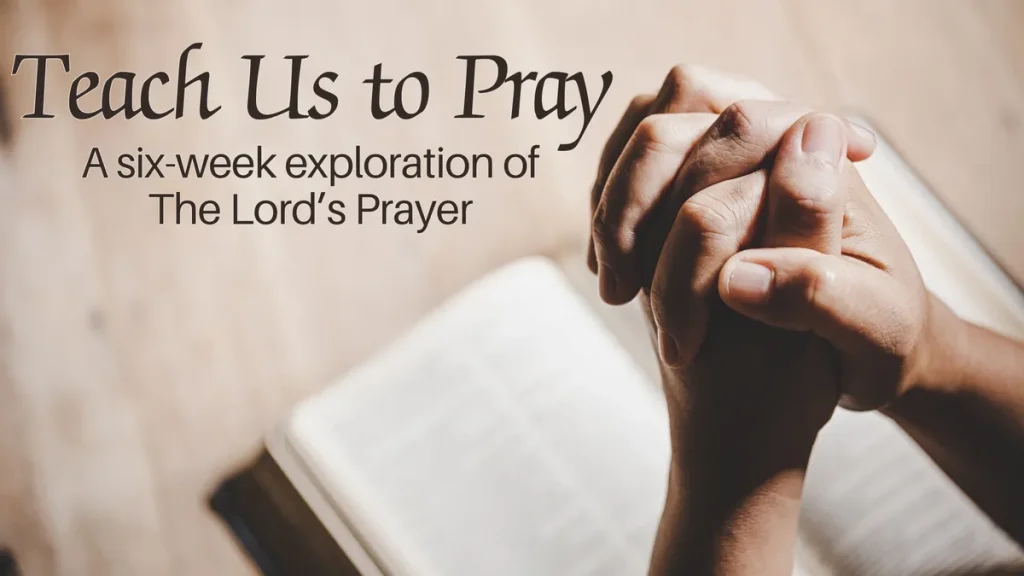Teach Us to Pray
Teach Us to Pray - A Six-Week Exploration of The Lord's Prayer
Use this link to go to the series content page.
An Introduction to the Series
Some of our earliest memories of prayer may be simple prayers taught to us by a parent, grandparent, or Sunday School teacher.
The earliest prayers I can remember learning were, “Now I lay me down to sleep; I pray the Lord my soul to keep,” and “God is great, God is good, and we thank him for this food. By his hand must all be fed, give us Lord our daily bread.” I learned both of those when I was preschool age. I didn’t quite understand the table grace because I was confused by part of it, but I didn’t want to admit my ignorance to the rest of my family.

One night, after we said grace, I finally couldn’t stand it any longer and I asked my mom and dad, “What’s an emwe?” They looked at me with confused faces and said, “What do you mean, ‘What’s an emwe?’” I replied, “You know, ‘God is great, God is good emwe thank him for this food…’” Everyone had a good laugh and explained that it was “and we,” not “emwe.” But, at times, it was said so fast out of habit, it was hard for me to understand the words, and I didn’t want other people to know I wasn’t getting it.
From that childhood memory, there are several truths that stand out to me.
- Prayer is something we can learn if we are willing to be taught.
- Prayer is something we grow in over time; we should not pray the same way as an adult as when we were children.
- It’s important not to rush through words in praying, but to truly hear what we are saying.
- We don’t need to fear our lack of knowledge or experience in prayer, because truly we will always be beginners.
In A Guide to Prayer, Norman Shawchuck observes,
“On the one hand, prayer is a gift. It is something we receive, and we are to wait in silent expectation for the gift. On the other hand, we can learn how to pray and we are to give ourselves to the discipline of learning how to pray.”
One of the other prayers I learned at a young age is what we call The Lord’s Prayer — even though it probably should be called The Disciple’s Prayer, because it is how the followers of Jesus are to pray.
In April and May, we will do a six-week series on this foundational prayer that Jesus taught his first followers. This is a wonderful small group opportunity.
Although there are times when our most earnest prayers are not answered for reasons we don’t know, we also hopefully have seen prayer change people, perhaps by seeing them healed, or come to faith, or strengthened to face adversity.
One thing is sure, when we pray, we are often the ones who are influenced the most.
As we will share in worship each week, each piece of The Lord’s Prayer contributes something specific for us to pray about. Yet, in a broader sense, all of that increases our awareness of God is prayer.
There are many ways to pray beyond The Lord’s Prayer.
Christians of the 2nd and 3rd centuries spoke of three methods of prayer — verbal, silent thought, and contemplation, a type of prayer in which we focus our attention on a brief prayer or word.
To nurture prayer in our life, we will need to create a space in our days for solitude and silence, as well as praying, as we move through the activities of the day – especially driving!
Our prayers may include time to express our adoration of God, confession of our sins, praying for others, and praying for ourselves.
O. Hallesby describes prayer this way:
“To pray is to let Jesus come into our hearts... It is not our prayer which moves the Lord Jesus. It is Jesus who moves us to pray... From time immemorial prayer has been spoken of as the breath of the soul. The air which our body requires envelopes us on every hand. The air of itself seeks to enter our bodies and, for this reason, exerts pressure upon us. It is well known that it is more difficult to hold one’s breath than it is to breathe. We need but exercise our organs of respiration, and air will enter into our lungs and perform its life-giving function to the entire body. The air which our souls need envelopes all of us at all times and on all sides. God is round about us in Christ on every hand, with His many-sided and all-sufficient grace. All we need to do is to open our hearts.”
I hope you will join with a small group of other BBC folks as we learn to pray from the prayer Jesus taught his disciples.
Praying for you, Pastor Doug Scalise
